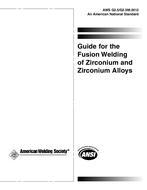No products
 View larger
View larger
AWS G2.5/G2.5M:2012
M00002139
New product
AWS G2.5/G2.5M:2012 Guide for the Fusion Welding of Zirconium and Zirconium Alloys
standard by American Welding Society, 01/17/2012
Full Description
The standard Guide for the Fusion Welding of Zirconium and Zirconium Alloys provides instructional guidance for thewelding of zirconium and zirconium alloys. This guide explains processes, equipment, materials, workshop practices,joint preparation, welding techniques, tests, and the repair of defects.In stock
More info
Table of Contents
Page No.
Personnel v
Foreword vii
List of Tables xi
List of Figures xi
General Requirements 1
Scope. 1
Units of Measure. 1
Safety 1
Normative References 1
Terms and Definitions 2
Introduction 3
Elements that Influence Zirconium Weld Integrity 3
Zirconium Metallurgy 3
Zirconium Weld Discontinuities 4
Arc Welding Processes 4
Gas Tungsten Arc Welding (GTAW) 4
Gas Metal Arc Welding (GMAW) 4
Plasma Arc Welding (PAW) 4
Equipment 5
Power Source 5
Welding Torch 5
Tungsten Electrodes 6
Materials 6
Base Metals 6
Filler Metals 8
Procedure Qualification 8
Workshop Practice 8
Workshop Layout 8
Material Identification and Storage 9
Inert Gas Protection 9
Inert Gas Distribution 9
In-Chamber Welding 10
Open Air Welding 11
Shielding Gases 13
Argon Safety 14
Joint Preparation 14
Joint Design 14
Cutting 15
Preliminary Preparation 16
Final Cleaning for Welding 16
Fitup and Tack Welding 17
ix
Page No.
Welding Technique 17
Welding Parameters 17
Preheating 18
Filler Metal Practice 18
Starting and Stopping the Arc. 18
Electrode Practice 18
Wire Feeding 18
Interpass Cleaning 18
Interpass Temperatures 19
In-Process Weld Quality Tests 19
Visual Inspection 19
Dew Point Testing 19
Bend Testing 21
Hardness Testing 21
Nondestructive Test 21
Radiography 21
Liquid Penetrant Testing 22
Ultrasonic Inspection 22
Mandatory Heat Treatment of Zirconium Grade 705 22
Repair of Defects 22
Fabrication Defects 22
Repairs Following Service Failures 23
Porosity 23
Filler Metals for Welding Zirconium Alloy Metal Joints 23
Annex A (Informative)—Requirements of Base Metals 25
Annex B (Informative)—Requirements of Filler Metals 27
Annex C (Informative)—Informative References 29
Annex D (Informative)—Guidelines for the Preparation of Technical Inquiries 31
List of AWS Documents on Joining Metals and Alloys 33
x
List of Tables
Table Page No.
General Electrode Amperage Guidelines 7
ASTM/ASME Specifications for Product Forms 7
Recommended Shielding Gas Purity and Dew Point 9
Typical Joint Designs 15
Typical Parameters for GTAW of Zirconium 17
Surface Color in Zirconium Welds 20
Bend Test Requirements for Zirconium Alloys 21
Chemical Composition Requirements of Base Metals 25
Tensile Strength Requirements of Base Metals 26
B.1 Chemical Composition Requirements of Filler Metals—Weight Percent 27
List of Figures
Figure Page No.
Large Diameter Gas Cup and Lens for Zirconium Welding 5
Tungsten Electrode Tip Shape 6
Rigid and Collapsible Plastic Chambers Purged with Argon 10
Typical Trailing Shield Design 12
Examples of Back-Up Shields for Manual GTAW 13
Color Sequence in Zirconium 20
xi
This page is intentionally blank.
xii
xii
Guide for the Fusion Welding
of Zirconium and Zirconium Alloys
General Requirements
Scope. This guide provides information on welding processes and procedures that are recommended for use in zirco- nium fabrication. The document presents detailed and up-to-date technical information on the “best practices” to allow first time users of zirconium as well as established fabricators to join zirconium parts into high quality components.
Units of Measure. This standard makes use of both U.S. Customary Units and the International System of Units (SI). The latter are shown within brackets ([ ]) or in appropriate columns in tables and figures. The measurements may not be exact equivalents; therefore, each system must be used independently.
Safety. Safety and health issues and concerns are beyond the scope of this standard; some safety and health infor- mation is provided, but such issues are not fully addressed herein. Safety and health information is available from the following sources:
American Welding Society:
ANSI Z49.1, Safety in Welding, Cutting, and Allied Processes
AWS Safety and Health Fact Sheets
Other safety and health information on the AWS website Material or Equipment Manufacturers:
Material Safety Data Sheets supplied by materials manufacturers
Operating Manuals supplied by equipment manufacturers Applicable Regulatory Agencies
Work performed in accordance with this standard may involve the use of materials that have been deemed hazardous, and may involve operations or equipment that may cause injury or death. This standard does not purport to address all safety and health risks that may be encountered. The user of this standard should establish an appropriate safety program to address such risks as well as to meet applicable regulatory requirements. ANSI Z49.1 should be considered when developing the safety program.
Normative References
The standards listed below contain provisions that, through reference in this text, constitute mandatory provisions of this AWS standard. For undated references, the latest edition of the referenced standard shall apply. For dated references, subsequent amendments to, or revisions of, any of these publications do not apply.
1

